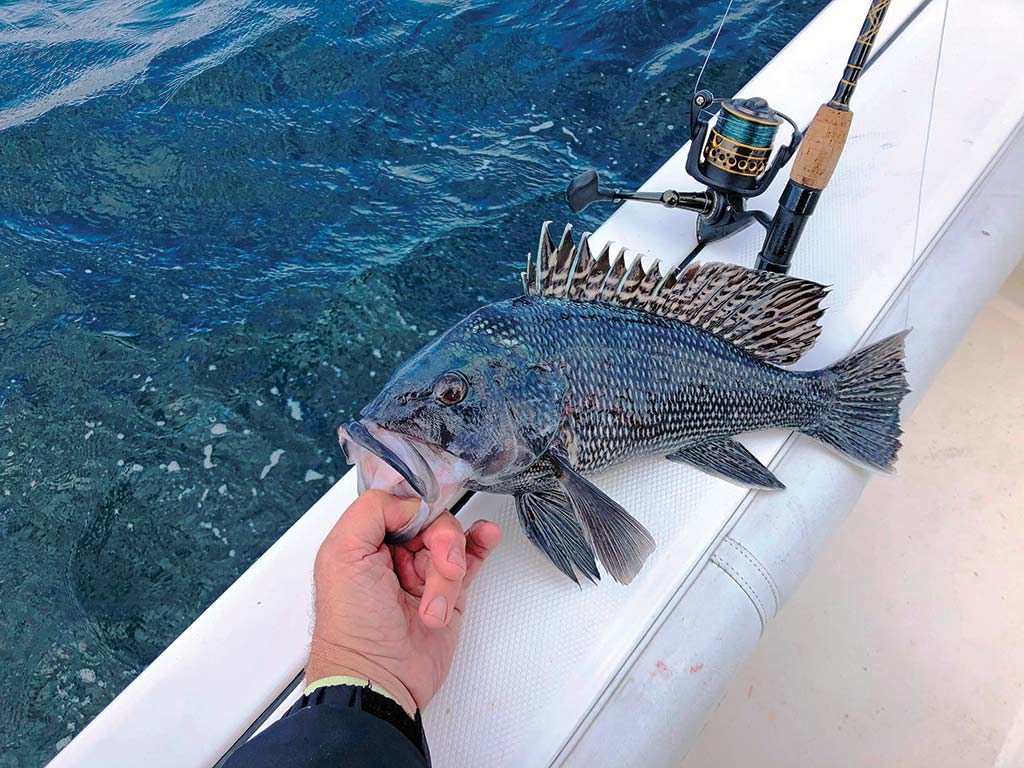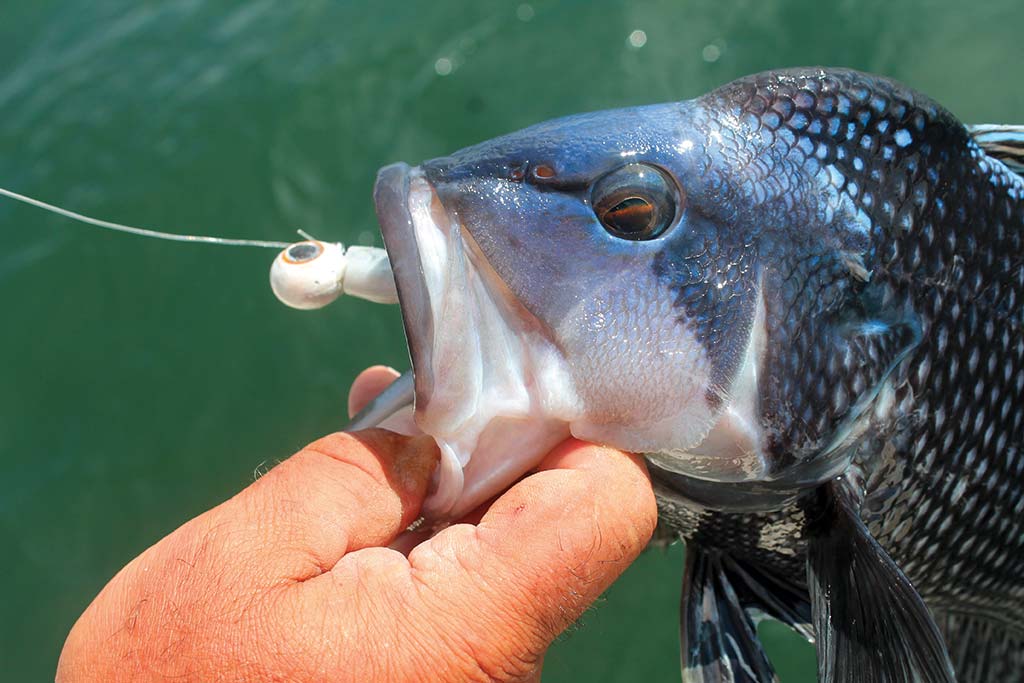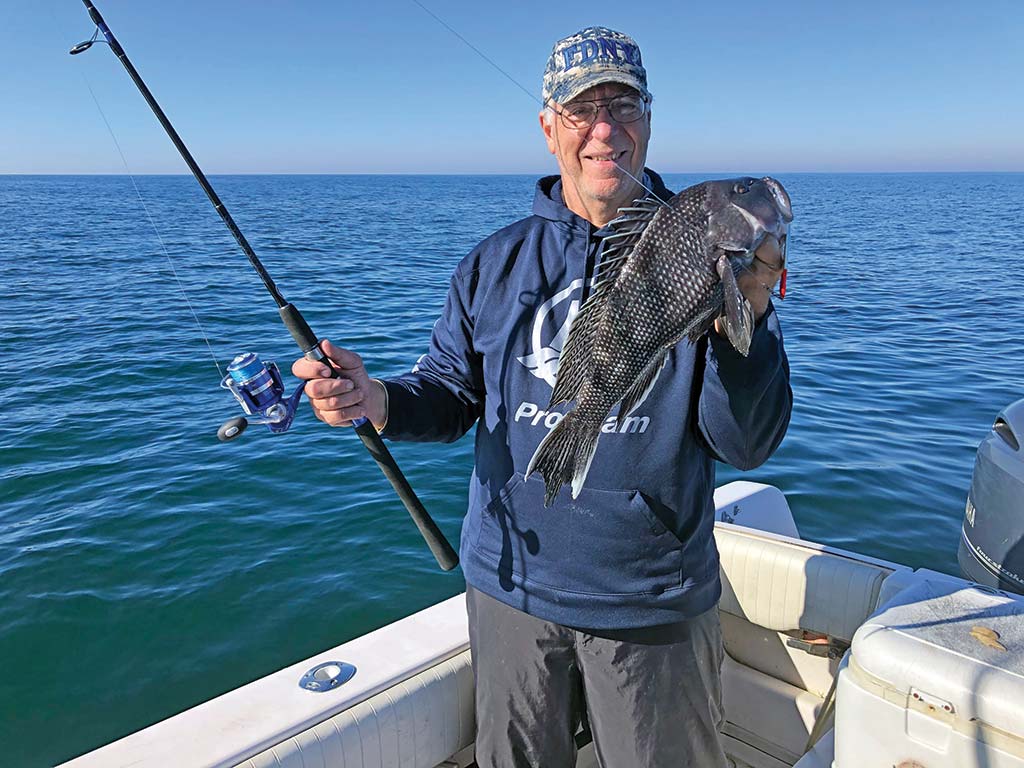
There are many reasons why “the other bass” has become a favorite target of light tackle anglers throughout the Northeast.
Striped bass, weakfish, bluefish, false albacore and even fluke are all popular targets for light tackle anglers who favor artificials over bait for working the inshore waters of the Northeast. Not too many years ago, black sea bass would have garnered little support for inclusion on this list,
but how times have changed. Once the realm of sinker bouncers soaking clam or squid baits on unnecessarily heavy conventional tackle, the resurgence in sea bass stocks has led to a greater appreciation for “the other bass.”
Their current level of abundance has resulted in an expansion of their range, which makes them readily accessible from New Jersey to Massachusetts. Their numbers and the impressive size of some of these fish have also made them attractive to many anglers. The sea bass population now extends northward into parts of New England where they had never, or rarely been caught before. This expansion has resulted in excellent fishing opportunities in near shore areas, as well as in deeper ocean waters, giving small boatmen the ability to target them in relatively calm, sheltered waters during various parts of the season.
They have become so abundant in recent years that some lobstermen claim they are doing irreparable damage to the lobster population because of their voracious appetite. Sea bass are especially fond of baby lobsters. Their gluttonous appetite and aggressive feeding habits make them easy targets for a wide assortment of artificial lures and baits, including soft plastics, bucktails, diamond jigs and butterfly style jigs.
Their susceptibility to artificials is one of the main reasons for their surge in popularity. The growth of light tackle fishing over the past decade, along with their population boom, made targeting sea bass a no-brainer. Their tenacious fighting ability, their penchant for artificial lures, and the ability to catch large numbers of fish in the 2 to 5-pound range in relatively shallow water make them the perfect fit for light tackle. The exception is late in the season when fishing for them is concentrated on offshore wrecks and the prudent choice becomes beefier tackle.
Light action spinning rods in the 6 to 7-foot range matched to 2500 and 3000 series reels spooled with 10 to 15-pound test braid have become the tackle of choice for many anglers these days. It allows you to fish smaller and lighter payloads, often the key to making sea bass and other species bite when larger offerings are ignored. The lighter, fine diameter lines allow you to be down on or near the bottom where the bulk of feeding activity is taking place, and the light tackle allows for a better presentation and much better feel than heavier gear. Part of that presentation is the ability to cast your offering and work it back to the boat when there is little or no drift, or at the other extreme, when the drift is too fast, but more on this later. At the terminal end, I like a 4 to 6-foot length of 20-pound fluorocarbon connected to the braid with your choice of an Alberto, FG or Double-Uni knot. I always tie leadheads and bucktails direct to the fluorocarbon with an improved clinch knot.

Thanks to tremendous strides in fishing tackle technology, especially in rods and lines, there is little concern that the biggest sea bass, or the biggest fluke or striped bass for that matter, will prove to be too much for your light tackle. Encountering these other gamefish while targeting sea bass is a real possibility in many areas and ads to the appeal of this light tackle approach, as they are equally vulnerable to the same lures and techniques.
There are plenty of choices when it comes to the business end where light tackle is concerned, but two key components are bucktails and plain lead jig heads. Everyone seems to have their own preference for the type of head they prefer on these jigs. My personal preference for bucktails is the old standby Smilin’ Bill, the ball head and the narrower Spro-shaped head, which tends to have a faster sinker rate due to that narrower shape. When it comes to plain jig heads, a ball head with a pair of large eyes is my first choice.
A naked bucktail will draw strikes from sea bass but is no match for a bucktail or leadhead dressed with one of the many different types of soft plastics, and especially scent infused baits such as Gulp, Fishbites and ZMan. Sea bass are suckers for these baits and I’ve done very well with the Gulp Sand Eel, Swimming Mullet, Shrimp, Grub and Minnow. My favorite Fishbites is the Dirty Boxer Curly Tail Grub, but I’ve also had very good success with the Butt Kicker Paddle Tail. ZMan’s Doormatadorz has proven especially durable and able to withstand repeated strikes from the rough mouths of sea bass. Dressing your hook with strips of Fat Cow or Otter Tails, soft plastics like Bass Assassins, Keitech Swimbaits, Fin-S Fish, Jelly Worms or a host of others will all draw strikes from aggressive sea bass.
If you still feel the urge to apply bait to this light tackle approach, adding a squid strip to a bucktail or lead head, or a piece of clam to a plain jig head will certainly draw strikes, but you will find yourself spending more time replacing stolen baits. Also, take note that on several trips where other anglers were fishing bait on standard bottom rigs, the light tackle approach produced more and bigger sea bass, although I cannot say for sure why.
Depending on water depth, current and drift speed, leadheads ranging from ½ to 1.5 ounces should cover most situations, with 2 ounces at the extreme end. I have yet to go to 2 ounces but depending on where you fish, you might consider a few as backup. I have fished in up to 75 feet of water in a running tide with 1 and 1-1/4-ounce leadheads with no problem. The key is angling your casts into the direction of your drift and allowing the lure to get down to the bottom before beginning your retrieve. Your retrieve should be just fast enough to keep the slack out of your line as the distance between your lure and the boat narrows. If you feel you are losing touch with the bottom as the jig nears the boat, open your bail and allow it to fall back to the bottom. Very often, the hit will come as the boat passes by your jig and it begins to rise from the bottom.

At the other end of the spectrum, and this goes for lots of other species, not just sea bass, one of the great advantages to fishing light spinning tackle is the ability to cast and retrieve your jig when there is little or no drift, such as slack tide, or a wind against tide situation. I can’t tell you how many times other anglers have blamed the dying current for fish going off their feed, when in fact it is because their baits, which had relied on the current for movement, were now sitting still on the bottom. Another plus is you cover a lot more bottom when casting as opposed to simply letting your offering drag in the wake of a drifting boat, which also requires more weight due to the added drag on your line.
If you find yourself fishing from an anchored boat, cast as far upcurrent as possible and allow your lure to get down to the bottom as it is carried with the current before working it back to the boat. Your retrieve should be just fast enough to keep any slack out of your line, which will keep the lure along the bottom until it is directly below you.
When it comes to working your jig, there are times when just a snap of the wrist will work as well as any retrieve, but over the long run, the snap jigging technique, a very exaggerated hard jigging motion, will outfish most other retrieves. The negative side to snap jigging is it becomes tiring and it can be difficult to keep up the pace during a lengthy stint on the water. For that reason, I suggest using a mix of both retrieves and lean toward the most productive as the day progresses. Regardless of how you work your jig, it is critical that you maintain contact with your lure throughout the retrieve, and develop a feel for the bottom. If you are not making consistent but brief contact with the bottom, your catch rate will suffer.
As I alluded to earlier, another one of the virtues of this light tackle approach with artificials for sea bass is the ability to draw strikes from other species. We have had days when targeting sea bass that we had striped bass, bluefish, weakfish, porgies and fluke take the same offerings. Bluefish can at times be a problem since they make quick work of soft plastics and have a habit of biting off lead heads and bucktails.
Many anglers consider black sea bass regulations unnecessarily stringent in most states, given that the stock is well above their targeted biomass. With relatively shorter seasons, in some cases in-season closures, and reduced bag limits (Go to thefisherman.com for sea bass regulations in your state.), you will be releasing many of the sea bass you catch. Going the light tackle route will provide a lot more enjoyment with every one of the fish you keep, and the ones you release. For a large part of the season, there is no reason to gear up with heavy gear when you can still fill your limit and have a lot more fun doing it with light tackle. And, if you consider a fresh fish dinner a plus after a day on the water, you will not be disappointed. Sea bass are excellent on the dinner table and adapt to a wide range of cooking and recipes.




